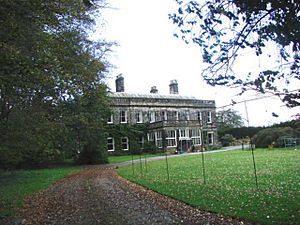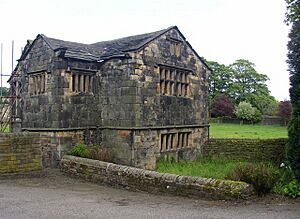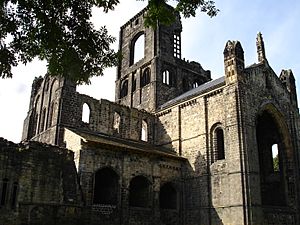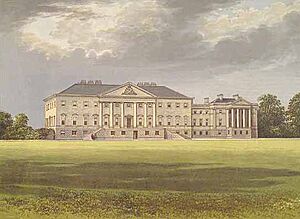List of monastic houses in West Yorkshire facts for kids
This article lists the monastic houses that once existed in West Yorkshire, England. Monastic houses were places where groups of people, like monks or nuns, lived together. They dedicated their lives to religious practices, prayer, and often helped their local communities.
These houses played a big role in medieval times. They were centers for learning, farming, and caring for the sick. Many of them were dissolved, or closed down, in the 1500s during a period known as the Dissolution of the Monasteries. This happened when King Henry VIII decided to take control of the Church in England.
Alien houses are included, as are smaller establishments such as cells and notable monastic granges (particularly those with resident monks), and also camerae of the military orders of monks (Knights Templars and Knights Hospitaller). Monastic hospitals are included where they had the status or function of an abbey, priory, friary or preceptor/commandery.
- Abbreviations and key
| Symbol | Status |
|---|---|
| None | Ruins |
| * | Current monastic function |
| + | Current non-monastic ecclesiastic function (including remains incorporated into later structure) |
| ^ | Current non-ecclesiastic function (including remains incorporated into later structure) or redundant intact structure |
| $ | Remains limited to earthworks etc. |
| # | No identifiable trace of the monastic foundation remains |
| ~ | Exact site of monastic foundation unknown |
| ≈ | Identification ambiguous or confused |
Locations with names in italics indicate possible duplication (misidentification with another location) or non-existent foundations (either erroneous reference or proposed foundation never implemented) or ecclesiastical establishments with a monastic name but lacking actual monastic connection.
| EH | English Heritage |
| LT | Landmark Trust |
| NT | National Trust |
Monastic Houses in West Yorkshire
Here's a look at some of the important monastic houses in West Yorkshire.
Arthington Priory
Arthington Priory was a home for Cluniac nuns. These nuns followed the rules of the Cluniac order, focusing on prayer and a quiet life. The priory was started around 1154 or 1155 by Peter de Ardington. It was dissolved in 1539, meaning it was closed down. Later, the land was given to Thomas Cranmer, who was the Archbishop of Canterbury.
Barwick-in-Elmete Monastery
This was a very old Saxon monastery. It was likely founded before the year 730 by an abbot named Thrydwulf. A Saxon monastery means it was built during the Anglo-Saxon period of English history. It might have been destroyed in the 800s. Today, you can still find some Saxon remains in the local church.
Collingham Monastery
Collingham Monastery was another Saxon monastery. It was founded by Eanfled, who was the daughter of King Edwin. This monastery was likely destroyed around 875. It is thought to be the place known as Ingetlingum from old records.
Esholt Priory
Esholt Priory was a home for Cistercian nuns. The Cistercian order was known for its simple life and hard work. This priory was founded in the 12th century. It was closed down in 1539. Today, a house called 'Esholt Hall' stands where the priory used to be.
Headley Priory
Headley Priory was a home for Benedictine monks. These monks followed the rules of Saint Benedict, which included a life of prayer and work. This priory was an alien house, meaning it was controlled by a larger monastery in France called Marmoutier. It was founded before 1125. The priory was dissolved in 1414 and its property was given to Holy Trinity, York.
Kirklees Priory
Kirklees Priory was a priory for Cistercian nuns. It was founded before 1138. The priory was dedicated to the Blessed Virgin Mary and St James. It was dissolved in November 1539. The land was later given to John Tasburgh and Nicholas Savill.
Kirkstall Abbey
Kirkstall Abbey began as a small community of hermits. It became a large Cistercian monastery in 1152. The monks came from Fountains Abbey, first settling in Barnoldswick before moving to Kirkstall. The land for the abbey was given by Henry de Lacy. Kirkstall Abbey was dissolved on November 22, 1540. Today, the ruins of the abbey are owned by Leeds Corporation, and people can visit them.
Newland Preceptory
Newland Preceptory was a house for the Knights Hospitaller. This was a military religious order that cared for pilgrims and the sick. The manor was given to them by King John after 1199. The chapel at Newland was rebuilt in 1519. The preceptory was dissolved in 1540. The chapel was taken down around 1860, but some parts might still be in a barn nearby.
Nostell Priory
Nostell Priory was a home for Augustinian Canons Regular. These were priests who lived together under a strict rule. The community was first founded around 1114 by Robert de Lacy. They moved to the current site of Nostell Priory before 1120. The priory was dedicated to Saint Oswald. It was dissolved in 1539 or 1540. Today, a large mansion called 'Nostell Priory' stands on the site.
Pontefract Blackfriars
Pontefract Blackfriars was a house for Dominican Friars. These friars were known for their preaching and teaching. The house was founded in 1256 by Edmund de Lacy. It was dedicated to St Richard. The friary was dissolved on November 26, 1538. The land was later given to William Clifford and Michael Wildbore.
Pontefract Priory
Pontefract Priory was a home for Cluniac monks. It was founded around 1090 by Robert de Lacy. Like Headley Priory, it started as an alien house, dependent on a French monastery. However, it became independent in 1393. The priory was dedicated to Saint John. It was dissolved in 1539.
Syningthwaite Priory
Syningthwaite Priory was a home for Cistercian nuns. It was founded around 1160 by Bertram Haget. The priory was dedicated to St Mary. It was dissolved on August 3, 1535. Today, parts of the old priory are built into a farmhouse on the site.
Temple Newsam Preceptory
Temple Newsam Preceptory was a house for the Knights Templar. This was another famous military religious order. It was founded before 1181. The Knights Templar were dissolved between 1308 and 1312, and their properties were taken away.
Wetherby Preceptory
Wetherby Preceptory was also a house for the Knights Templar. It was founded after 1240 and was connected to another Templar house called Ribstone. After the Knights Templar were dissolved (1308–1312), the property became a 'camera' (a smaller house) for the Knights Hospitaller.
Woodkirk Priory
Woodkirk Priory was a smaller house, or 'cell', for Augustinian Canons Regular. It was dependent on Nostell Priory. It was founded between 1138 and 1147 by William de Warenne and others. The priory was dissolved in 1539 or 1540.
See also
- List of monastic houses in England
- List of monastic houses in Wales
- List of monastic houses in Scotland
- List of monastic houses in Ireland





